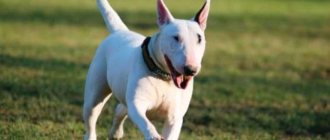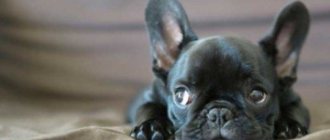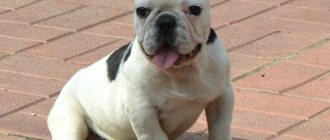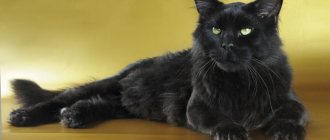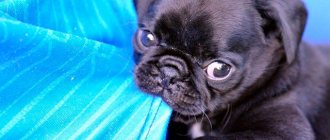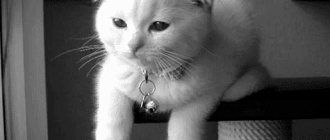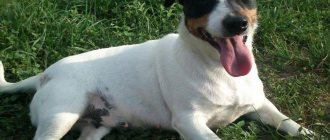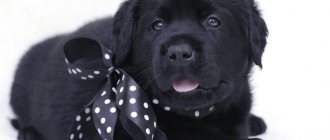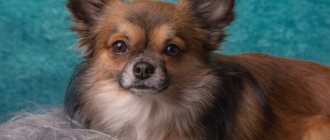French bulldogs are fighting dogs with a multifaceted character, lively temperament and memorable appearance.
They differ from other breeds in their muscular and prominent physique with small dimensions, as well as a variety of coat colors.
French bulldogs have high intelligence and good health; they are excellent protectors and companions, capable of largely copying the character of their owner.
In this article you will learn about the most common types of French bulldog colors and see pictures and photographs with examples of them.
What colors of French bulldog are there?
Along with the accepted standard and colors considered a breed defect, there are varieties of color that fall into the category of acceptable. After strict testing and evaluation by experts, black and brindle bulldogs can be allowed to compete. The dog looks black in appearance, but upon closer inspection, interspersed with red hairs are noticeable. The main feature of this type of color is the predominance of charcoal color and the brightness of red inclusions.
Unlike the FCI and RKF, the American Kennel Club recognizes the rare blue French bulldog, despite the fact that it is a lighter tone of gray with a silver tint.
Gray (ash)
Gray color comes in different shades - from light to classic mouse and steel. There are Frenchies with wool of a single color, with a slight tan or even a white spot on the chest. Most often the coat is short and shiny.
Black
Black color is not included in the breed standard. Variations and degrees of intensity appear depending on the genetic characteristics of the French. Dogs can be:
- dark;
- black and tan;
- spotted.
Black bulldogs with a white chest, neck or toes on their paws look especially elegant and beautiful.
Ginger
Red-colored dogs are a special case of fawn color, so they are accepted at exhibitions and competitions. It is acceptable to have light fawn spots on the body, except for the chest, neck and belly. Red necessarily remains the main background, against which there may be a dark mask and markings over the entire surface of the body.
Brown
Previously, brown color was included in the breed standard. Today, animals with this color are considered a defect, and their participation in exhibitions is impossible. The shades of color are varied - from dark and bright to light, pastel tones. Bulldogs may have longitudinal stripe markings and a mask on their face.
Chocolate
There are many options for chocolate color. Classic – brown-brown with a pronounced shine. A distinctive feature of chocolate is its uniform color. The color was artificially bred by breeders and is considered a defect in the breed. If she is classified as brindle or fawn, the standard is recognized.
Lilac
One of the rare colored coats of bulldogs is purple or lilac. Most often, such individuals are obtained by breeders living in the western United States of America. A light purple tint makes the Frenchie unusual and attractive. Options for purple color are varied - from cold blue to dark purple with a silver tint. There may be light markings on the chest and muzzle. A special feature of lilac bulldogs is their light eye color from birth and throughout their lives.
Sable
Sable color is rare. The Franz's coat looks like fawn, but with darker hairs throughout the surface. Some dogs have a creamy base color. The sable color is non-standard, the length of the dark hairs is different. They are especially clearly visible in puppies. In the first weeks the hairs are grayish, and later they turn red. In most cases, sable French Bulldogs have a dark mask on their face.
Marble
Despite the fact that marbled bulldogs are in great demand, breeding them is prohibited. The gene that provides color is dominant and is passed on to subsequent generations along with hereditary diseases. The main background of the coat of French bulldogs can be dark, almost black, brown, red or light. Spots or stripes of different colors and shapes are unevenly distributed across it. Marble puppies are often born with heterochromia.
Spotted
Spotted bulldogs are called white and fawn. The main color is white, and on it there are spots of brindle or brown. Intensity has several types:
- Medium spotting - white and brown markings are evenly distributed, another name is mantle coloring.
- Limited spotting - black with white tie.
- Absorbing - can be white-brindle with a predominance of light coat.
Merle
Merle or merle is similar to merle. Not included in the breed standard. Characterized by the presence of blurry, indistinct spots of different sizes and shades (white, brown, coffee). There is no mask on the face.
Tan
The peculiarity of the tan color is marks on the paws, above the eyes, on the chest, on the cheekbones, and under the tail. They have a contrasting color in relation to the main one.
Yellow (sand)
The pigment of a bulldog's coat with a yellow color is called golden. It is brighter than beige and fawn. The ears, chest, back of the paws, and belly have a lighter shade.
Faun
The fawn color is a variety of fawn, including red, orange, and café au lait. The most beautiful bulldogs are those with a black mask on their faces.
Pale yellow
The fawn color combines several shades:
- cappuccino;
- red;
- brown;
- wheat
The accepted breed standard allows for spots on the belly, forehead and chest. Their location in other places is considered a defect. A common variant of the Frenchie is fawn with black and white splashes or tiger stripes. The dog's belly is always milky white. The peculiarity of the color of the puppies is red hairs. Later, the long ones will become lighter, the short ones will darken.
Beige
The beige color of bulldogs resembles fawn, the difference is in the color of the lips, eyelids and nose. The first ones are cream, the second ones are black. Beige bulldogs are born with red fur. Gradually it brightens. The color is recognized as a standard only in the USA.
Character of dogs
French bulldogs are distinguished by their pronounced ability to adopt the personality traits of their owners.
General characteristics of the breed :
- mobility;
- physical endurance;
- intelligence.
Dogs of this breed are trainable , but they learn slowly.
The French Bulldog is unobtrusive, but does not tolerate loneliness well, and by temperament is a companion dog. Representatives of the breed have a highly developed maternal instinct.
IMPORTANT!
French bulldogs have a calm disposition, but they need good upbringing; in the absence of it, they can show aggression both towards other animals and people, and towards members of their own family.
Rare coat colors
To obtain new exotic shades, dog breeders carry out breeding work. White, red, cream, blue, and two-colored individuals are extremely rare. Not all of them are allowed for further breeding due to being outside the standard.
Red
Red is a variety of fawn with a rich red tint. Belongs to the elite group and is valued by dog handlers. The cost of red Frenchies is high.
Cream
Cream dogs are a type of beige with a light nose and lips. There is no mask on the face, the color of the coat is close to white. The suit is not recognized by the International Canine Federation.
White
Pure white French Bulldogs are rare. Sometimes puppies are born light-colored, but after some time they turn into brindle. A common option is white with red spots. The markings can be any color, including a dark mask on the face. The exception is white dogs with black spots.
Blue
Blue French bulldogs are most often called blue to emphasize the unusualness of their color. This is a type of gray with a rich, silvery tint. The coat is beautiful, rare, but not recognized by the breed standard.
Black and white
Bicolor combines two colors – black and white. Each of them can act as the main one. The standard allows two-color coloring if the spots are located on the head, back and sides. The total area of the marks does not exceed 20% of the dog's body surface.
Albino
Albinos among French bulldogs are as rare as among other breeds. They inherit the corresponding genes from two parents. A pure albino has no pigmentation of the nose, mucous membranes or paw pads. Their eyes are pink, blue or light amber. The skin is transparent, blood vessels are visible through it. This species is considered a genetic disorder.
History of the origin of the breed
The Frenchman comes from bulldogs from England and Spain, and a separate breed was developed in the 18th century. The appearance of purebred dogs in Great Britain is associated with the fact that at that time bloody dog fights flourished, which required the appearance of a small fighting individual. The positive side was that the owner could easily transport the pet in his arms. After some time, the dogs found their way into the homes of the French elite. Then the breed was officially registered in France, and the dog was first introduced in 1896.
In the twentieth century, French bulldogs became desirable pets for the Russian elite. Between 1941 and 1945, the fashionable breed gradually disappeared from Russian territory. The animal population began to be restored only in the 50s of the twentieth century.
Genetic factors affecting color
Genetic features determine not only the color of the bulldog, but also the intensity of the color:
- Two fawn or red Frenchies will not produce brindle puppies. From such a combination you can only get the corresponding colors.
- Two brindle bulldogs can produce fawn puppies, but only if both dogs are carriers of the fawn gene (that is, one of the parents was fawn). Theoretically, from such a mating the litter will be 25% fawn, 50% brindle with the fawn gene, 50% brindle without the fawn gene.
- Two spotted bulldogs will not produce solid colored puppies.
- Solid-colored dogs can get spotted-colored puppies if both parents had ancestors of the same color.
Note! All modifier genes are inherited regardless of the main coat shade.
Merle color
It's marble. Not included in the breed standard, although the genes that form it are dominant. Three shades (in most individuals white, reddish brown and dark brown) form vague patterns of different shapes and sizes. There is usually no “mask”.
View this post on Instagram
Posted by @frenchbulldog.puppies.ua
Marbled bulldogs often have heterochromia (unequal coloration of the iris). There is a high probability of having a litter with genetic abnormalities.
Interesting Facts
These adorable dogs can catch mice and rats just as well as cats.
Dogs of this breed never cease to amaze their owners and others. Turns out:
- One French bulldog sailed on the Titanic with his new owner to New York. After his pet died in the disaster, the man filed a lawsuit against the company and won large compensation for the loss of his pet.
- Among the admirers of this breed are many creative personalities: Mayakovsky, Henri Toulouse-Lautrec, Elton John, Yves Saint Laurent, Marilyn Manson, Leonardo DiCaprio and others.
- There is a cafe in France called La Bulldog. Its interior is decorated with a large gallery of paintings depicting French bulldogs from all over the world. Visitors with dogs are also very welcome here, and if you don’t have one, two charming local dogs can keep you company.
What do newborn puppies look like?
Newborn puppies, regardless of gender, weigh from 190 to 350 grams. The head is large, occupies up to a third of the body length (6-7 cm), the nose is black, moist, short and upturned, the nostrils are wide.
The puppy's eyes are set wide apart, the eyelids are tightly closed (puppies are born blind). The oral mucosa is light pink. The puppy's front paws are straight, the pasterns are strong, and the paws are not splayed.
The belly of a newborn puppy is rounded, but not swollen, soft and has a small layer of fat that is gathered into a fold with two fingers. The anal area is light pink. The tail is short, broken, can be curved, and is never located above the line of the back.
The fur of newborn puppies is smooth, velvety and shiny.
IMPORTANT!
Representatives of non-standard colors may have various genetic abnormalities and are more demanding in care and nutrition.
Black
View this post on Instagram
Posted by Barney French bulldog to Moscow (@puppies_from_barney)
The black bulldog is the rarest variety. A continuous color is obtained by crossing brindle dogs for a long time.
The black-haired French pet is excluded from participation in competitions and breeding. Therefore, the black cubs born are castrated. The bulldog is bought exclusively as a companion; in terms of character traits, it is in no way inferior to the varieties recognized by the standard.
It is necessary to distinguish between solid and black-and-white bulldogs. The intensity of the color is influenced by the genetic characteristics of the individual. Since the variety was obtained by crossing brindle dogs, in the vast majority of cases the body is not black, but motley. It’s just that the specks and stripes are small, almost merge with the black background, and are difficult for human eyes to notice. The chest and limbs are decorated with white and beige spots; less often, markings cover the back.
Interesting Facts
These adorable dogs can catch mice and rats just as well as cats.
Dogs of this breed never cease to amaze their owners and others. Turns out:
- One French bulldog sailed on the Titanic with his new owner to New York. After his pet died in the disaster, the man filed a lawsuit against the company and won large compensation for the loss of his pet.
- Among the admirers of this breed are many creative personalities: Mayakovsky, Henri Toulouse-Lautrec, Elton John, Yves Saint Laurent, Marilyn Manson, Leonardo DiCaprio and others.
- There is a cafe in France called La Bulldog. Its interior is decorated with a large gallery of paintings depicting French bulldogs from all over the world. Visitors with dogs are also very welcome here, and if you don’t have one, two charming local dogs can keep you company.
Life expectancy and health
Mixed breeds usually vary in life expectancy. Sometimes some genetic changes can weaken it and make it less resistant to disease. But it happens that the dog becomes stronger and healthier than ordinary French bulldogs.
IMPORTANT!
As a rule, the French live up to 10 years. Sometimes this limit reaches 12 years.
There are cases where, with proper care, regular prevention and treatment, Frenchies lived up to 15 years.
Diseases
that affect fawn bulldogs :
- Eye problems, vision loss, conjunctivitis, eye loss.
- Dermatitis, allergic skin reactions.
- Problems with the spine, it happens that bulldogs are paralyzed or their hind legs fail.
- Breathing problems. It is difficult to tolerate heat and stuffiness.
- Ear problems. You need to carefully care for the ear, or the dog may suffer from otitis media.
- Difficult birth. Often a bulldog mother dies during childbirth. Pregnancy must be monitored carefully, and childbirth must be delivered by a professional.
- Obesity. It is important to feed your pet properly.
How do puppies change as they age?
At 1 month, puppies rapidly gain body weight and have a large appetite. After the eyes open, you should make sure that their irises are the same color.
Puppies are agile and slightly clumsy; by the end of the first month of life they reach a weight of 1-1.5 kg.
At 2 months, puppies learn to stand on their hind legs with emphasis on a hard surface, playful and funny. During this period, their ears become fully erect, the spots on their body become more distinct, their weight reaches 2.5 kg, and the puppies begin to remember their name.
At 3 months, the replacement of baby teeth (incisors) begins, skin folds become more noticeable, and weight reaches 3-5 kg.
From 4 months, fangs are replaced, and increased growth of tubular (long) bones begins. From this month, puppies begin to toilet train or ask to go for a walk , weight ranges from 4 to 6 kg (girls are usually smaller than boys).
At 5 months, the puppy’s small molars are replaced, muscle mass is gained, and the weight reaches 7-8 kg.
At 6 months, males weigh up to 10 kg, females - up to 8-9 kg, the rate of weight gain increases by 2.5-3 times , the height at the withers reaches 35-37 cm.
At 7-8 months, the change of teeth is completed, the growth of tubular bones slows down, the muscle relief is clearly visible, the mask on the muzzle is clearly visible, and the weight reaches 12 kg.
At 9 months, puppies are actively exploring the world around them, are able to remember and follow commands, are trainable, and weigh up to 13 kg.
From the 10th month, the jaw is maximally developed, the bite is fully formed, and the weight is 14-16 kg.
At 11-12 months, puppies gradually approach the appearance of an adult dog:
- folds and color are well defined;
- all muscles are developed;
- the back is strong;
- cylindrical chest;
- The dog is active and physically strong.
The weight of a puppy of eleven to twelve months reaches 15 kg.
Read more information about the weight of French bulldogs here.
What to feed?
Comparison of English or French Bulldog
Most often, owners begin to gradually feed puppies two weeks after their birth. In just one month they can feed themselves. You can use both natural food and commercial dry food for feeding.
Babies up to three months should be fed 4-5 times a day, as they grow quickly and have a good appetite. When feeding dry food, you need to take into account the norms indicated on the packaging. But be sure to give them a lot of water. When preference is given to natural food, then only fresh food should be given to them.
- Meat – both raw and boiled. It can be beef, chicken, or rabbit. It should make up up to 50 percent of the total daily diet.
- Cereals should make up up to 25 percent of the daily diet. It can be rice, buckwheat, or oatmeal. Your dog will eat porridge better if you add a little vegetable oil to it.
- Up to 20 percent of the diet should be fermented milk products. It can be either cottage cheese or kefir.
- Once a week you should give your pets a couple of raw eggs.
- Up to 5 percent are vegetables; you can give them both raw and boiled.
It is forbidden to include smoked, fried or salty foods, as well as sweets or a lot of flour in the bulldog menu. After all, they tend to be overweight. An adult bulldog should be switched to 2 meals a day. If the nutrition is correct, it will extend the years of a dog's life.

